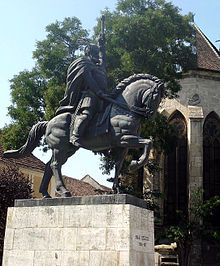General Ion Coman , who in 1976 was at the head of the Romanian army, reported that, initially, the model of this statue had entered the competition for Alba Iulia , and will be placed near the Union Hall. The objection was also raised that the statue is a bit tall compared to the buildings in the area, although this was not a decisive argument to eliminate it. However, regardless of the arguments, Nicolae Ceaușescu intervened, and gave Oscar Han the victory. His argument was rather sentimental in nature and started from the idea that Oscar Han, born in 1891, had reached a fairly advanced age, and that was likely to be his last representative work. Thus, in 1968, in Alba Iulia, in front of the Prince’s Palace, on the occasion of the half-centenary of the union of Transylvania with Romania, the statue proposed by Marius Butunoiu was not unveiled, but the equestrian statue of Mihai Viteazul from Alba Iulia , made by the sculptor Oscar Han. Because Butunoiu had reached a fairly advanced stage with the work, Ceaușescu also proposed, in compensation, that this second “Mihai Viteazul” be placed either in Călugăreni , where Sinan Pasha was thrown from his horse, or in Șelimbăr, from where, later, Mihai Viteazul set off for Alba Iulia. After much debate about this alternative, in the end, Ceausescu decided that the statue should be erected in Cluj, because it brought an extra Romanian history there, with the unconfessed hope that Mihai Viteazul will neutralize, in terms of image, Matei Corvin , represented in the Matia Corvin Monumental Ensemble in Cluj , which, historically speaking, identifies – not only spiritually – with the Hungarian community, rather than with the Romanians.
Photographers unknown








